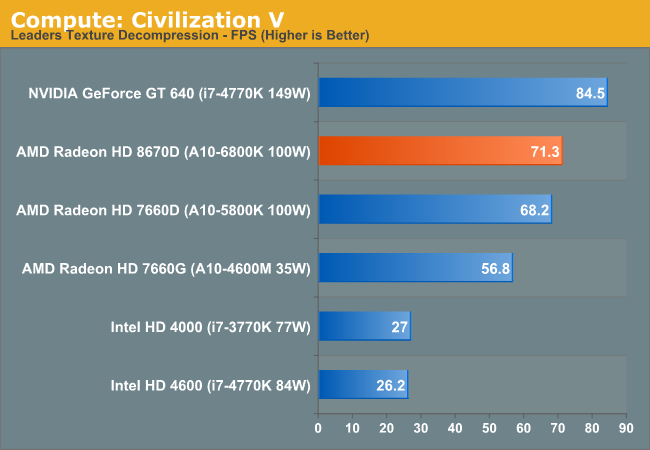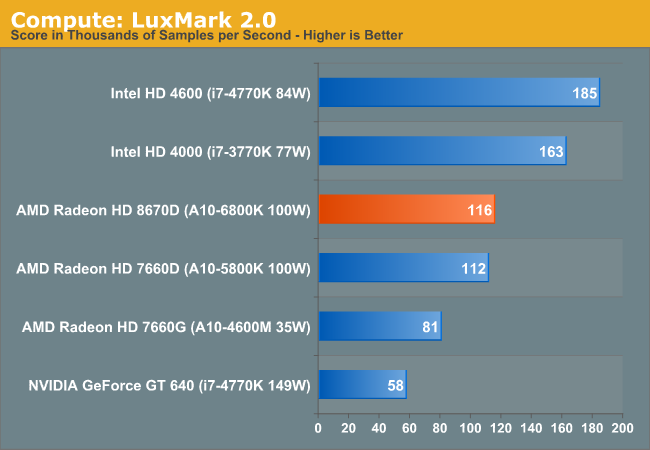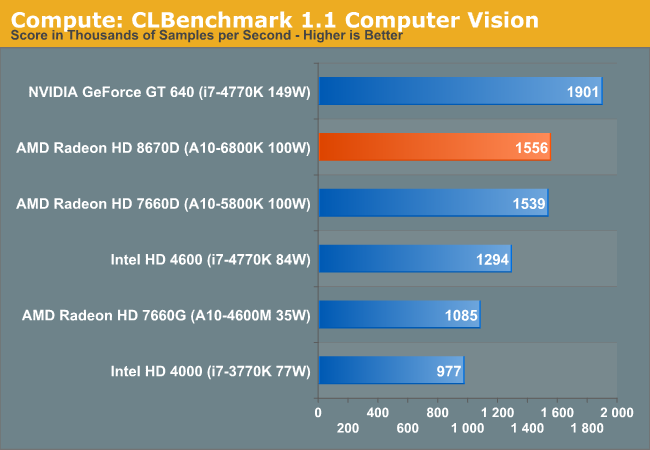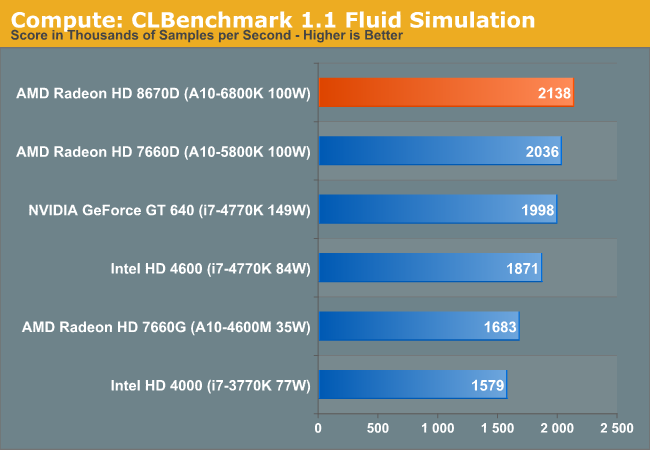AMD's Richland vs. Intel's Haswell GPU on the Desktop: Radeon HD 8670D vs. Intel HD 4600
by Anand Lal Shimpi on June 6, 2013 12:00 PM ESTCompute
As always we'll start with our DirectCompute game example, Civilization V, which uses DirectCompute to decompress textures on the fly. Civ V includes a sub-benchmark that exclusively tests the speed of their texture decompression algorithm by repeatedly decompressing the textures required for one of the game’s leader scenes. While DirectCompute is used in many games, this is one of the only games with a benchmark that can isolate the use of DirectCompute and its resulting performance.

AMD does extremely well in our sole DirectCompute test, outperforming Intel's latest desktop graphics solution by a huge margin.
Our next benchmark is LuxMark2.0, the official benchmark of SmallLuxGPU 2.0. SmallLuxGPU is an OpenCL accelerated ray tracer that is part of the larger LuxRender suite. Ray tracing has become a stronghold for GPUs in recent years as ray tracing maps well to GPU pipelines, allowing artists to render scenes much more quickly than with CPUs alone.

Haswell GT2's OpenCL performance can be very good, which is what we're seeing here. HD 4600 ends up being almost 60% faster than the Radeon HD 8670D.
Our 3rd benchmark set comes from CLBenchmark 1.1. CLBenchmark contains a number of subtests; we’re focusing on the most practical of them, the computer vision test and the fluid simulation test. The former being a useful proxy for computer imaging tasks where systems are required to parse images and identify features (e.g. humans), while fluid simulations are common in professional graphics work and games alike.


AMD and Intel trade places once again with CLBenchmark. Here, Richland does extremely well.
Our final compute benchmark is Sony Vegas Pro 12, an OpenGL and OpenCL video editing and authoring package. Vegas can use GPUs in a few different ways, the primary uses being to accelerate the video effects and compositing process itself, and in the video encoding step. With video encoding being increasingly offloaded to dedicated DSPs these days we’re focusing on the editing and compositing process, rendering to a low CPU overhead format (XDCAM EX). This specific test comes from Sony, and measures how long it takes to render a video.

The last compute test goes to Intel, although the two put up a good fight across the entire suite.










102 Comments
View All Comments
coder543 - Thursday, June 6, 2013 - link
Why are we not testing versus Crystalwell enabled Iris 5200? This is the most important information, even if it isn't in the same price category necessarily.testbug00 - Thursday, June 6, 2013 - link
Because that makes no sense as a testing point.The i7 tested is not in the same price gap ether (an i3 would probably lose a lot of this partial CPU stuff) but the iGPU performance barely changes.
And how is that the most important information????? If anything it is the least important as you cannot buy Iris (pro) iGPU 5x00 on desktop unless embedded.
JarredWalton - Thursday, June 6, 2013 - link
The bigger factor is that Iris Pro simply isn't available as a desktop part -- it's only available in the BGA package i7-4770R, which OEMs can use in things like all-in-one PCs. The other place where we'll see Iris Pro (for now) is on laptops with the HQ series parts, but again that's not going up against desktops. GT3 and GT3e effectively don't exist as desktop offerings right now, but that's not too surprising as laptops stand to benefit most from improved iGPUs.jeffkibuule - Thursday, June 6, 2013 - link
On the desktop, it's only in one SKU that's only for OEM systems.FriendlyUser - Thursday, June 6, 2013 - link
Let me remind you that the Iris5200 is a $650 part. In fact, the ONLY situation where the Crystalwell part makes sense is when TDP and power requirements/battery concerns are the absolute priority. Otherwise, it's much cheaper to get a non-iris part and a separate mobile gpu (say, radeon 8970M) that offers vastly superior performance.mikk - Thursday, June 6, 2013 - link
No this is wrong. Iris Pro starts at 440 USD in mobile. Crossfire is not comparable since you get horrible micro stuttering.Hrel - Thursday, June 6, 2013 - link
They fixed the stuttering a long time ago mikkGigaplex - Thursday, June 6, 2013 - link
It wasn't that long ago and it's still not completely fixed.Guspaz - Friday, June 7, 2013 - link
They improved the stuttering for single GPU use. Both nVidia and AMD suffer from micro stuttering with multi-GPU solutions. It's a different problem set.Samus - Friday, June 7, 2013 - link
AMD is worse than nVidia's stuttering, but is easily fixed by adding a third GPU. So instead of using two high end cards in Crossfire/SLI, using three mid-high end cards virtually eliminates stutter.